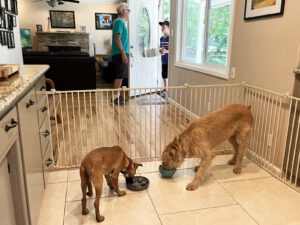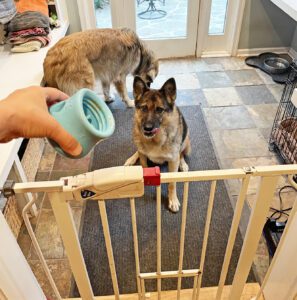
If the usual scene at your front door is chaotic – if a knock or the doorbell makes your dog bark, jump, spin, or try to escape – the answer is within reach: Try a dog gate. It’s the incredibly underrated, relaxed management solution that we trainers reach for again and again. Sure, eventually we might like to get to the point where a gate is no longer needed, and it’s lovely when you can train your dog to perform a polite sit or reliable “go to mat” behavior on cue, but the immediate stress relief a gate provides for everyone (including the dog) often makes it the first step in a training plan. Frankly, it works so well it ends up being the last step, too!
Create a New Routine for the First Minutes
Most folks don’t realize, until they try the gate solution, just how critical the first few moments after the doorbell are. The “new person on our property” event is a high-arousal situation for almost every dog. Big feelings are to be expected. However, with smart use of a gate and some food, you can change the default doorway dynamic, improving the whole visit.
Here’s a plan that will change the doorbell and/or knocks on the door into a signal for a calm, rewarding mini-routine that takes place comfortably away from the doorway. In short:
- Choose a spot where you can place a gate. (Note that the incredible variety of great gates now on the market means it doesn’t have to be the old standard doorway-mounted version. See “Types of Dog Gates.”) Ideally, this location shouldn’t be too far from where visitors enter – if it’s going to take a long time to run with your dog to that area, and then back to the door alone, you may find yourself sometimes skipping the exercise, which will reduce its effectiveness.
- Use food to lure your dog behind the gate whenever somebody’s at the door.
- Once there, offer a kibble scatter, a food-stuffed toy or LickiMat, or a bully stick, and soon enough just the sound of a knock or a doorbell will have your dog peacefully trotting back to that spot for a chewing/foraging activity rather than adding drama to the front door activity. (If you want to get to that automatic response more quickly, you can practice this by knocking on the door yourself, or enlisting help from a friend.)
Don’t let the steps intimidate you! This is easy. Part of the reason I love suggesting gates to clients is because a lot of people don’t like training! The second they hear, “First, do this, then to practice, do this,” they are done. So when it comes to the steps for teaching your dog to go behind the gate? Just lure with food. Use good enough food, and he’ll go. Do it enough and he will begin to go the second he hears the doorbell or knock – it’s usually just that easy.
Why This Routine Works
If you let doorway chaos reign – with barking, jumping, and frantic energy – that initial high arousal will climb, particularly if you have multiple dogs. You may be adding to it with repeated and unheeded calls of “sit” and “down,” which ramp up that energy, because you, too, seem aroused. Cue more stress all around, with a splash of guest discomfort.
If, instead, the doorbell in your home initiates a predictable and reinforcing activity behind a gate, dogs are often calm enough to be able to rejoin the humans almost immediately after the entrance. Giving the dogs a break from the intense doorway stress can be the thing that actually allows them to politely hang out with your guests much sooner.
For example, when we have a visitor at the door, my German Shepherd goes into the mud room for maybe 30 seconds (for as long as it takes me to open the front door) and then I immediately bring her right back out. At that point, she’s able to give a happy, calm sniff, and chill out completely.
But if I had let her stand right there for front-door duty? Oh, my. Hello, scary police dog! She’d bark and loom in a very intimidating fashion, and stay notably on alert for a few minutes. That dog is unrecognizable from the one who instead trots quickly to her mud room for a kibble scatter and emerges calmly 30 seconds later. (Trainer/ethologist Kim Brophey calls this the “Off-Duty Hack.” Rather than training a bunch of things like off and down and mat and stay, you simply convey “Hey, it’s okay, I’ve got the door thing handled. Relax, you’re off duty.” Works like a charm.)
Using the Right Food Activity
If you’re thinking that your dog would never willingly leave the all-important doorway job – or that no flimsy gate would keep him back there for more than a minute – you’re right! If you just pop the dog behind a gate with nothing to do but obsess over the stranger he can’t get to, for sure it could ratchet up the drama. What’s more, next time it would be harder to entice him behind the gate, since he learned it means he misses out.
So don’t do it that way! Instead, create a new doorbell-means-fun-times-behind-a-gate dynamic using a food activity that’ll keep your dog occupied for as long as necessary. When I was teaching my shepherd, I just used a quick kibble scatter (maybe 10 pieces of kibble tossed on the floor) because I didn’t need more than 30 seconds and she’s thrilled with all food, even her boring old kibble.
However, some dogs will take much longer (especially the first times you try this routine) to calm down enough to join the human party. In that case, you want to be prepared with something great to forage, chew, or lick that will last the five, 10, or 15 minutes it typically takes to relax. Here’s what’s key: While the dog is enjoying that LickiMat, bully stick, or food-stuffed toy, she’s listening to the stranger’s voice, with yours. She may be getting used to the new human’s scent. It’s ideal if she can actually watch you through the gate to be able to fully assess things and get comfortable with what’s happening. (This is why a gate is entirely different than closing a dog behind an actual door! Those two things feel entirely different to your dog.)
Chewing, licking, and foraging for food are fundamental canine activities that naturally relax our dogs. Typically, the longer your dog is occupied in this way behind that gate, the calmer she’ll become. Sometimes half an hour passes and you go to invite your dog to come join the humans and . . . she looks up and then goes back to her nap.
Note that the more your dog gets used to this new, predictably reassuring pattern, the less enticing and long-lasting your food activity needs to be. At this point with my shepherd, the kibble scatter may or may not happen, and she’s still happily going “off-duty.” Truly, I think she feels relief at having this clear alternate picture of what she can do at what feels to her like a high stakes moment.
Other Gate Uses
It’s not just the doorway chaos that makes a selection of gates a fantastic addition to any dog family. It’s all of the varying circumstances that will come up over the dozen-odd years ahead! Fences do indeed make good neighbors, and having an easy way to temporarily separate living beings can cut way down on stress.
Being able, at any given moment, to split guests and dogs, kids and dogs, dogs from each other, puppies from unsupervised carpets, and dogs from a teenager’s science fair project, goes incredibly far in eliminating unnecessary trouble. (If only more people used gates during holiday gatherings, we’d have fewer sad bite incidents.)
The more you use gates, the more you’ll love them – and the more you’ll love your dogs who suddenly seem so well behaved as they get used to the routine: “Oh, gate time. OK.”
Management THEN Training

Maybe you’re reading this and thinking, “Ha! She must be a terrible trainer if she needs to use physical separators instead of just teaching the dogs what to do!”
The thing is, the goal for the vast majority of my clients is just to live together happily, peacefully, with their dog. If a gate can accomplish two-way satisfaction tomorrow with about a minute of “training,” then that is a giant win. When stress goes away, the canine-human relationship heals. Happy human; happy dog.
Of course, that moment is an opportune time to venture into some fun-and-treat-filled training sessions! Sure, they might even involve doorway behaviors. But you know what will make those sessions more likely to succeed in the end? The fact that the pressure is off. Now that a gate is in place, there’s no deadline, no fear of failure. So if the dog learns that “mat” thing – what a fun trick! But if not? No biggie. The dog and the human are experiencing in-sync multi-species living all the same.






What a great article – I think gates are the “best thing since sliced bread” thing of the dog world. I use them to keep my ridgeback out of the kitchen and off the kitchen counters, which she is tall enough to reach. It has saved her from grapes, onions and knives (VERY expensive vet visits) and all things dangerous in the kitchen. Since counter surfing is inherently self rewarding behavior, it’s very hard to eliminate. At least when I’m out of the house, and the kitchen gate is closed, I know there will be no unfortunate accidents to greet me when I return. YAAAAA gates!
Thanks for this article! I adopted a 2-year-old rescue GSD about 6 months ago and he is a delightful and smart dog. I’ve taught him basic obedience commands and numerous tricks which he delights in but I have been unable to break him from the habit of jumping up on people. This includes visitors and myself. I’ve tried to redirect the behavior by giving a command which he promptly obeys (unless that command happens to be “stay”) but then as soon as the sit or down or whatever is completed he will resume his jumping. I may have inadvertently reinforced this behavior somehow since during his training sessions I will praise him for performing the desired behavior and then he often gets happy and excited and starts jumping as if getting to jump is his reward. He will obey the “off” command and often on his own sit in a “beg” position or sit and lift a paw (both are tricks that he knows and will sometimes do on his own to please me.) I can generally control the jumping on me by turning my back to him and ignoring until he calms down but this does not work when being introduced to new people. Gating seems worth a try. Any other suggestions would be greatly appreciated.
My three dogs are all crate-trained, so preventing access isn’t a problem, but even when confined, they go nuts when visitors arrive. The guests don’t get mobbed, but the decibel levels go way up, especially since these are big dogs with big voices!
It’s been a couple of years now, so their reaction is by now a default behavior (the “fault” being mine, of course), and probably hard to break. To make it worse, they react to the sound of the gate opening at the end of the driveway, way before anyone actually rings the bell.
Since being on constant guard for unpredictable visitors would be almost impossible, the occasional misses would reinforce the old behavior, so I think my best plan is to find a helper willing to open the gate repeatedly while I do the food scatter. If I can defuse that situation, I’ll move on to the front door, and hope that by the time visitors actually enter the house, the dogs’ trigger threshold will be at a manageable level.
If anyone has any other advice or better ideas, I’d love to hear them!